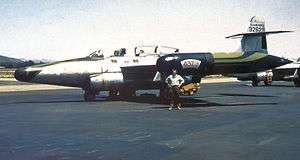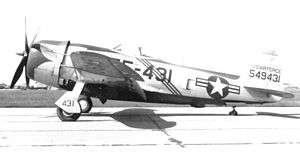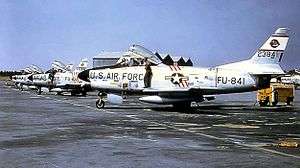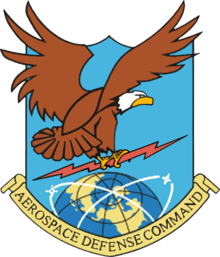4707th Air Defense Wing
The 4707th Air Defense Wing is a discontinued United States Air Force organization. Its last assignment was with the 26th Air Division of Air Defense Command (ADC) at Otis Air Force Base, Massachusetts where it was discontinued in 1956.
| 4707th Air Defense Wing | |
|---|---|
 F-89D Scorpion of the wing's 437th Fighter-Interceptor Squadron | |
| Active | 1 February 1952 – 18 October 1956 |
| Country | |
| Branch | |
| Type | Fighter Interceptor and Radar |
| Role | Air Defense |
| Part of | Air Defense Command |
| Insignia | |
| Air Defense Command Logo |  |
The wing was established in 1952 at Otis as the 4707th Defense Wing in a general reorganization of ADC, which replaced wings responsible for a base with wings responsible for a geographical area. It assumed control of several fighter Interceptor squadrons that had been assigned to the 33d Fighter-Interceptor Wing. In early 1953 it also was assigned six radar squadrons in New England, some of which were Air National Guard squadrons mobilized for the Korean War and its dispersed fighter squadrons were combined with colocated air base squadrons into air defense groups. The wing was discontinued in 1956 and its units transferred to other ADC commands, primarily the 33d Fighter Wing for units at Otis and the 26th Air Division for units at other locations.
History
Origin

The wing was organized at the beginning of February 1952[1] as part of a major reorganization of Air Defense Command (ADC) fighter units responding to ADC's difficulty under the existing wing base organizational structure in deploying fighter squadrons to best advantage.[2] The wing replaced the 33d Fighter-Interceptor Wing (FIW) at Otis Air Force Base, Massachusetts five days later and assumed control of the 33 FIW's operational elements.[1][3] The wing's 564th Air Base Group assumed support responsibilities for Otis AFB from the inactivating 33d Air Base Group and 33d Maintenance & Supply Groups.[4] The operational squadrons transferred from the 33d FIW were the 58th Fighter-Interceptor Squadron (FIS) and 59th FIS at Otis AFB and the 60th FIS at Westover Air Force Base, Massachusetts.[5][6] The 58th and 60th FIS flew F-86 Sabre aircraft,[7] while the 59th FIS was equipped with F-94 Starfire aircraft.[7] The wing also was assigned a federalized Air National Guard (ANG) squadron from the 101st FIW, the 133d FIS at Grenier Air Force Base, New Hampshire, flying World War II era F-47 Thunderbolt aircraft.[8] The wing mission was to train and maintain tactical flying units in state of readiness in order to defend the northeastern United States.[9]
Shortly after joining the wing, the 58th FIS converted from F-86 to F-94 aircraft.[7] Although it remained assigned to the wing until February 1953, the 59th FIS moved to Goose Bay Airport, Labrador on 28 October 1952 and was detached from the wing to Northeast Air Command until it was reassigned. In November its place at Otis was taken by the newly activating 437th FIS. The same month the 48th FIS activated at Grenier[10] to replace the 133d FIS, which was inactivated and returned to the control of the ANG.[8]
1953–1954 changes

The wing was reassigned to 32d Air Division as part of complete reorganization of Eastern Air Defense Force in February 1953. This reorganization also resulted in the activation of Air Defense Groups at ADC fighter bases, and the new groups assumed direct command of the fighter squadrons at these stations. The 564th Air Base Group redesignated as the 564th Air Defense Group[4] and the 58th FIS was reassigned to it at Otis,[6] The 518th Air Defense Group activated at Niagara Falls Municipal Airport, New York[11] and was assigned the 47th FIS, which had been assigned to another wing.[12]
Another result of this reorganization is that the wing assumed the radar detection, warning, and control mission and assigned six Aircraft Control & Warning Squadrons (AC&W Sq) to perform this mission.[13][14][15][16] Two of these squadrons, the 113th AC&W Sq and the 119th AC&W Sq, were federalized ANG squadrons, which were returned to state control in December,[13] while their personnel and equipment were transferred to the 700th AC&W Sq.[17] In the spring of 1953, five new AC&W Sqs were activated at Grenier AFB for transfer to stations in Canada.[18] These squadrons were all reassigned to Northeast Air Command shortly after their activation.[18] The 614th AC&W Sq moved to Georgia and was reassigned later in December.[14]
The wing was assigned an additional Air Defense Group in September 1954 when the 4700th Air Base Group at Stewart Air Force Base, New York was assigned an operational fighter squadron and redesignated the 4700th Air Defense Group.[19] The 4707th was also assigned an additional radar unit two months later.[20]
Project Arrow and replacement

In 1955, ADC implemented Project Arrow, which was designed to bring back on the active list the fighter units which had compiled memorable records in the two world wars.[21] As a result of Project Arrow, the 15th Fighter Group (Air Defense)[22] replaced the 518th Air Defense Group at Niagara Falls,[11] the 33d Fighter Group (Air Defense)[23] replaced the 564th Air Defense Group at Otis.[4] The 4700th Air Defense Group at Stewart[19] was replaced by the 329th Fighter Group (Air Defense), although the 329th group was assigned to another wing until mid-1956 due to shifting areas of air defense responsibility.[24]
Because Project Arrow called for fighter squadrons to be assigned to their traditional group headquarters, the 60th FIS at Westover returned to Otis and was replaced at Westover by the 337th Fighter-Interceptor Squadron, which took over its personnel and aircraft.[25][26] Later in 1955, the wing assumed command of two other fighter squadrons, the 49th FIS at Laurence G. Hanscom Airport, Massachusetts,[7][27] and the 324th FIS, which activated at Westover. Both squadrons flew F-86D aircraft.[7][28]
The wing was reassigned to the 26th Air Division in March 1956[1] when the 26th Air Division region of responsibility was extended, resulting in reassignment of radar and interceptor aircraft units as well.[15][29][30][31] Shortly thereafter, ADC reactivated Fighter Wings at its large installations and the 4707th was discontinued later that year[1] with its equipment and personnel being reassigned to the unit it had originally replaced, now designated the 33d Fighter Wing (Air Defense).[3]
Lineage
- Designated as the 4707th Defense Wing and organized on 1 February 1952
- Redesignated 4707th Air Defense Wing on 1 September 1954
- Discontinued on 18 October 1956
Assignments
- Eastern Air Defense Force, 1 February 1952
- 32d Air Division, 16 February 1953
- 26th Air Division, 1 March – 18 October 1956
Components
If no station is given, units were at Otis Air Force Base.
Groups
|
Fighter groups
|
Air defense groups
|
Squadrons
Fighter squadrons
|
|
Support squadrons
|
|
Radar squadrons
|
|
Stations
- Otis Air Force Base, Massachusetts, 6 February 1952 – 18 October 1956
Aircraft
|
|
|
|
See also
References
Notes
- Cornett, Lloyd H; Johnson, Mildred W (1980). A Handbook of Aerospace Defense Organization, 1946–1980 (PDF). Peterson AFB, CO: Office of History, Aerospace Defense Center. p. 66.
- Grant, C.L., (1961) The Development of Continental Air Defense to 1 September 1954, USAF Historical Study No. 126, p. 33
- Ravenstein, Charles A. (1984). Air Force Combat Wings, Lineage & Honors Histories 1947–1977. Washington, DC: Office of Air Force History. p. 59. ISBN 0-912799-12-9.
- Cornett & Johnson. p. 84
- Maurer, Maurer, ed. (1982) [1969]. Combat Squadrons of the Air Force, World War II (PDF) (reprint ed.). Washington, DC: Office of Air Force History. pp. 233, 235. ISBN 0-405-12194-6.
- Maurer, Combat Squadrons, p. 231
- Cornett & Johnson, pp. 116-117
- Cornett & Johsnon, p. 123
- Abstract, History 4707 Defense Wing Activation to June 1952 Retrieved 21 November 2013
- Maurer, Combat Squadrons, p. 209-210
- Cornett & Johnson, p. 82
- Maurer, Combat Squadrons, p. 206
- Cornett & Johnson, p. 94
- Cornett & Johnson, p. 154
- Cornett & Johnson, p. 157
- Cornett & Johnson, p. 165
- Cornett & Johnson, p. 100
- Cornett & Johnson, pp. 104–105
- Cornett & Johnson, p. 88
- Cornett & Johnson, p. 155
- Buss, Lydus H.(ed), Sturm, Thomas A., Volan, Denys, and McMullen, Richard F., History of Continental Air Defense Command and Air Defense Command July to December 1955, Directorate of Historical Services, Air Defense Command, Ent AFB, CO, (1956), p.6
- Robertson, Patsy AFHRA Factsheet, 15 Wing Archived 22 April 2014 at the Wayback Machine 12 February 2010 Retrieved 20 February 2012
- Bailey, Carl E., AFHRA Factsheet, 33 Operations Group Archived 22 March 2012 at the Wayback Machine 28 November 2007 Retrieved 20 February 2012
- Butler, William M., AFHRA Factsheet, 329 Armament Systems Group Archived 4 January 2013 at the Wayback Machine 27 December 2007 Retrieved 20 February 2012
- Maurer, Combat Squadrons, p. 417
- Cornett & Johnson, p. 127
- Maurer, Combat Squadrons, p. 213
- Cornett & Johnson, p. 125
- Cornett & Johnson, p. 156
- Cornett & Johnson, p. 167
- Robertson, Patsy, AFHRA Factsheet, 52 Operations Group Archived 28 January 2015 at the Wayback Machine 13 August 2010 Retrieved 3 March 2012
- Endicott, Judy G., AFHRA Factsheet, 47 Fighter Squadron Archived 13 May 2014 at the Wayback Machine 18 December 2007 Retrieved 3 March 2012
- Haulman, Daniel, AFHRA Factsheet, 48 Flying Training Squadron Archived 3 March 2016 at the Wayback Machine 10 July 2010 Retrieved 12 March 2012
- Robertson, Patsy, AFHRA Factsheet, 49 Flying Training Squadron Archived 3 March 2016 at the Wayback Machine 18 December 2007 Retrieved 12 March 2012
- Bailey, Carl E., AFHRA Factsheet, 58 Fighter Squadron 23 May 2011 Retrieved 12 March 2012
- Robertson, Patsy, AFHRA Factsheet, 59 Test & Evaluation Squadron Archived 28 September 2015 at the Wayback Machine 11 August 2011 Retrieved 12 March 2012
- AFHRA Factsheet, 60 Fighter Squadron. Retrieved 16 December 2015
- AFHRA Factsheet, 337 Flight Test Squadron Archived 23 February 2012 at the Wayback Machine 4 July 2008 Retrieved 12 March 2012
Bibliography
![]()
- Buss, Lydus H.(ed), Sturm, Thomas A., Volan, Denys, and McMullen, Richard F., History of Continental Air Defense Command and Air Defense Command July to December 1955, Directorate of Historical Services, Air Defense Command, Ent AFB, CO, (1956)
- Cornett, Lloyd H; Johnson, Mildred W (1980). A Handbook of Aerospace Defense Organization, 1946–1980 (PDF). Peterson AFB, CO: Office of History, Aerospace Defense Center.
- Grant, C.L., (1961) The Development of Continental Air Defense to 1 September 1954, USAF Historical Study No. 126
- Maurer, Maurer, ed. (1983) [1961]. Air Force Combat Units of World War II (PDF) (reprint ed.). Washington, DC: Office of Air Force History. ISBN 0-912799-02-1.
- Maurer, Maurer, ed. (1982) [1969]. Combat Squadrons of the Air Force, World War II (PDF) (reprint ed.). Washington, DC: Office of Air Force History. ISBN 0-405-12194-6.
- Ravenstein, Charles A. (1984). Air Force Combat Wings, Lineage & Honors Histories 1947–1977. Washington, DC: Office of Air Force History. ISBN 0-912799-12-9.
Further reading
- Winkler, David F.; Webster, Julie L (1997). Searching the skies: The legacy of the United States Cold War Defense Radar Program. Champaign, IL: US Army Construction Engineering Research Laboratories. LCCN 97020912.
- Leonard, Barry (2009). History of Strategic Air and Ballistic Missile Defense (PDF). , Vol II, 1955–1972. Fort McNair, DC: Center for Military History. ISBN 978-1-4379-2131-1.
- Leonard, Barry (2009). History of Strategic Air and Ballistic Missile Defense (PDF). Vol I. 1945-1955. Fort McNair, DC: Center for Military History. ISBN 978-1-4379-2131-1.
